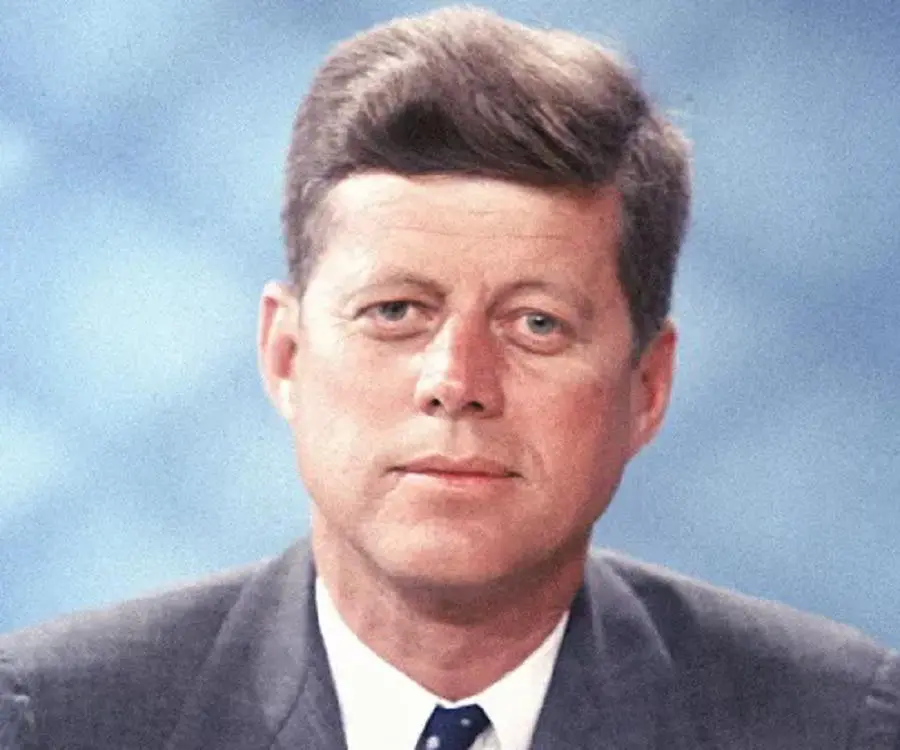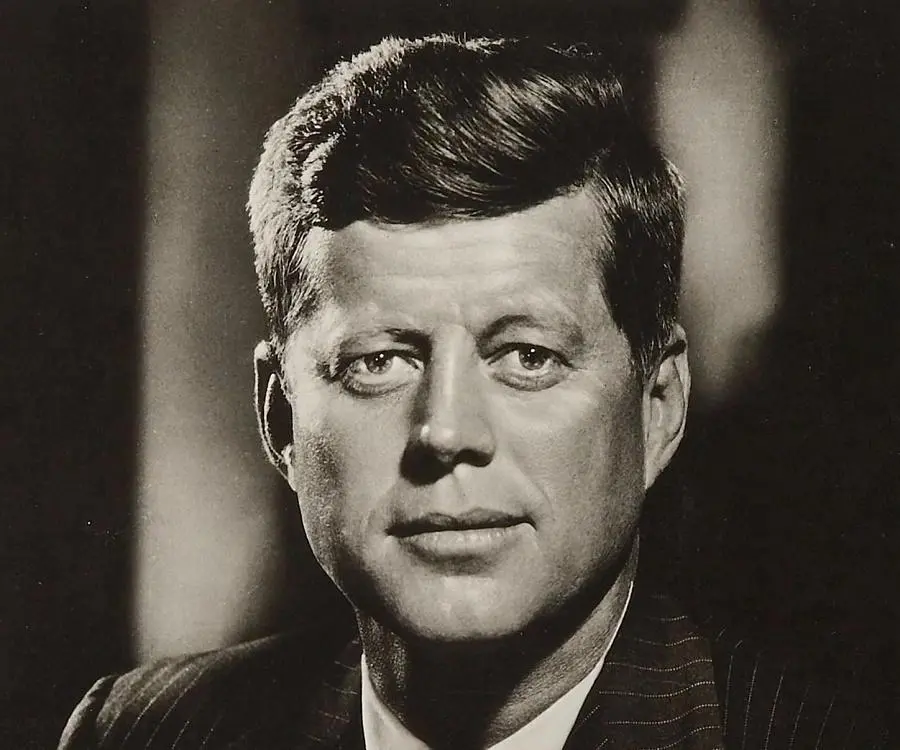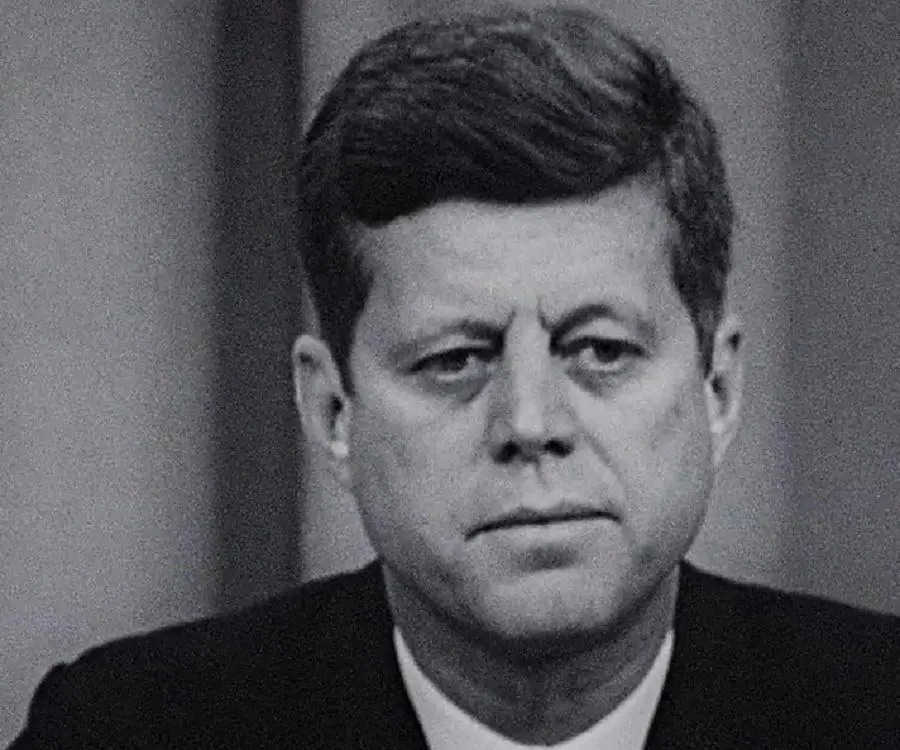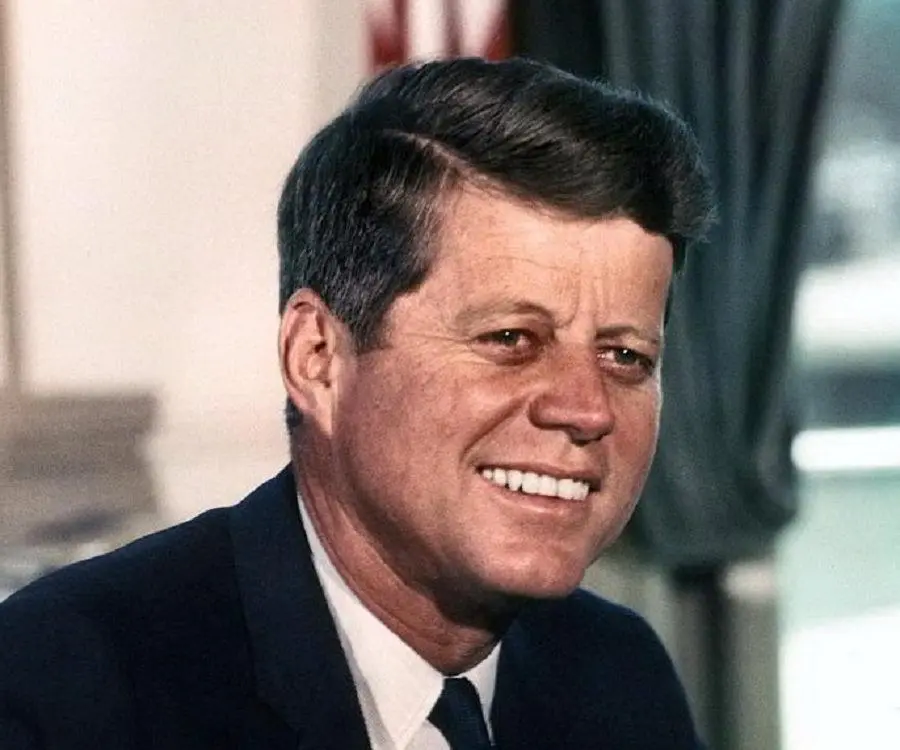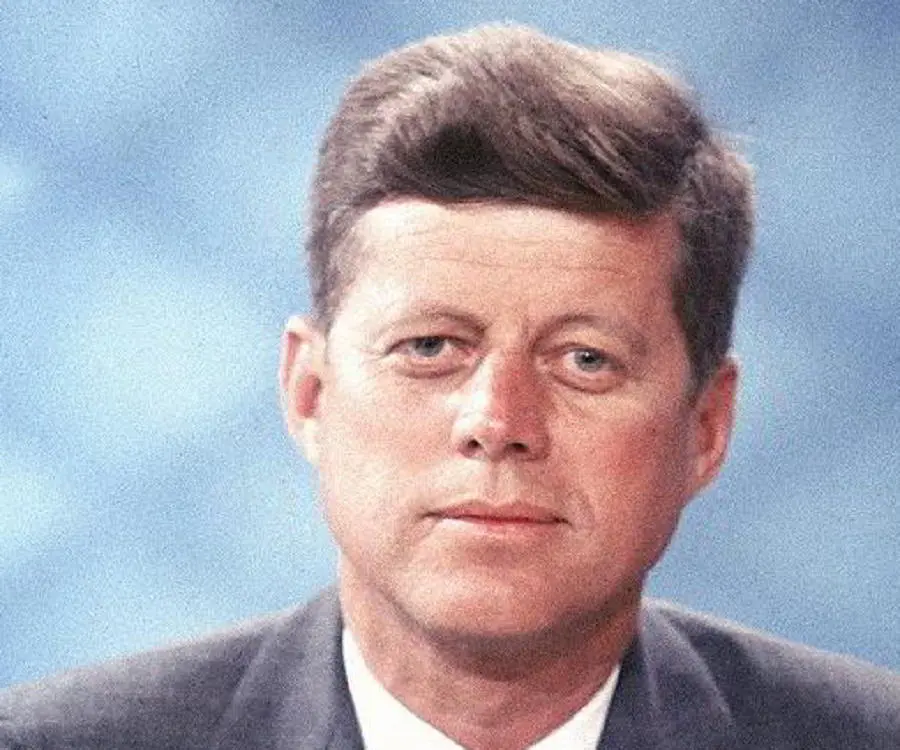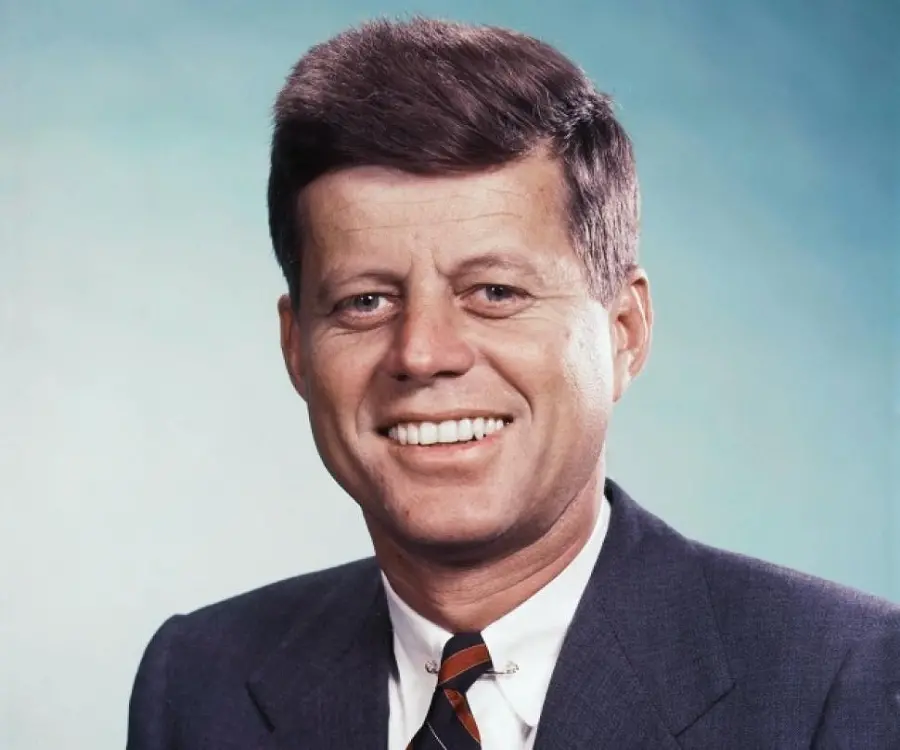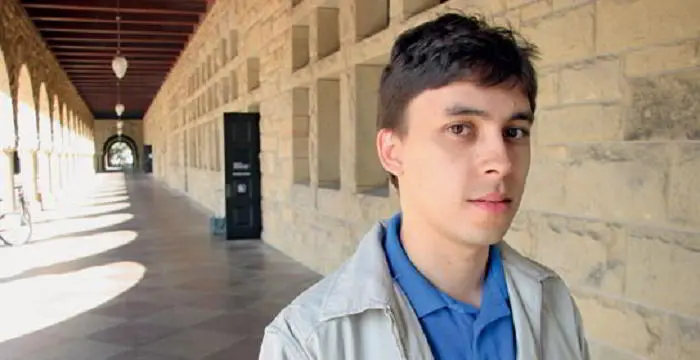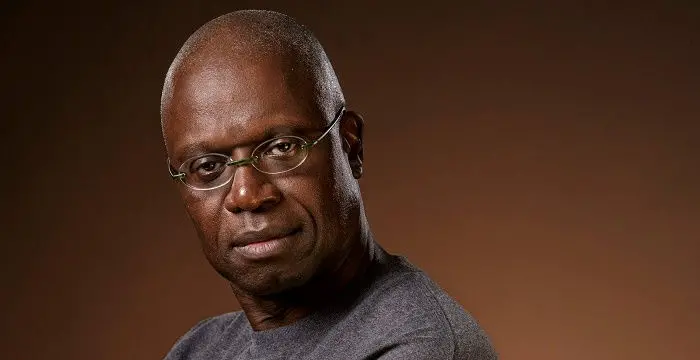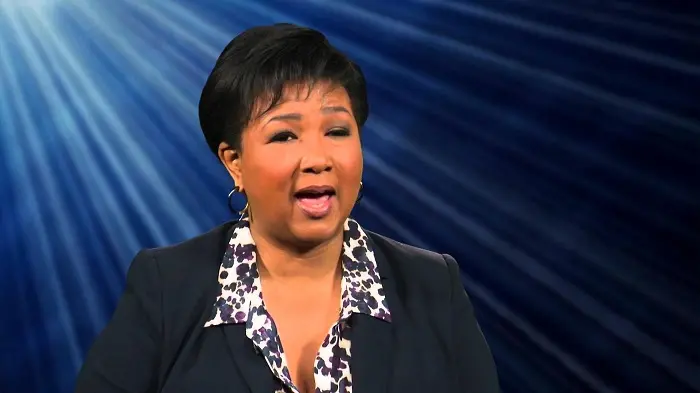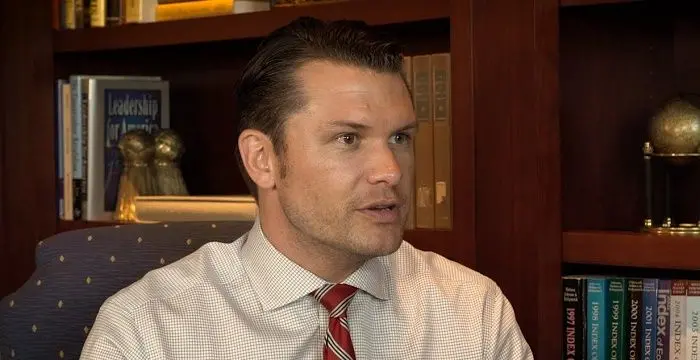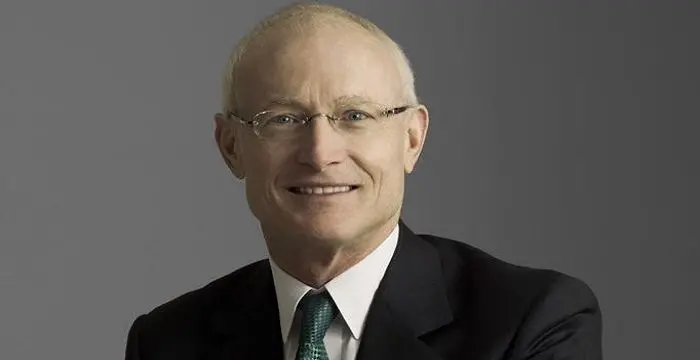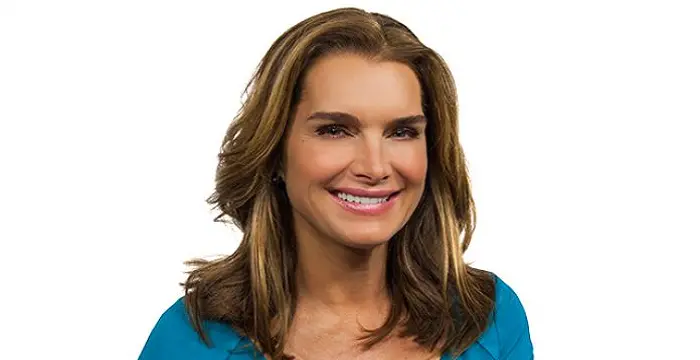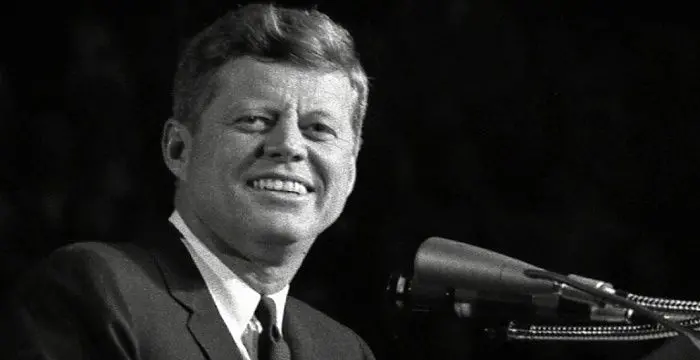
John F. Kennedy - 35th President of the United States, Family and Family
John F. Kennedy's Personal Details
John F Kennedy was the 35th President of the United States
| Information | Detail |
|---|---|
| Birthday | May 29, 1917 |
| Died on | November 22, 1963 |
| Nationality | American |
| Famous | Democrats, Harvard University, London School Of Economics (LSE), Princeton University, Stanford University, Leaders, Political Leaders, 35th President of the United States |
| Ideologies | Democrats |
| Spouses | Jacqueline Bouvier |
| Siblings | Joseph P. Kennedy Jr., Robert F. Kennedy |
| Childrens | 1963), Arabella (1956), Caroline B. (b. 1957), John F Jr. (1960–1999), Patrick B. (August 7-August 9 |
| Universities |
|
| Notable Alumnis |
|
| Founder / Co-Founder |
|
| Cause of death |
|
| Birth Place | Brookline |
| Political Ideology | Democratic |
| Religion | Roman Catholicism |
| Gender | Male |
| Father | Joseph P. Kennedy Sr. |
| Mother | Rose Fitzgerald |
| Sun Sign | Gemini |
| Born in | Brookline |
| Famous as | 35th President of the United States |
| Died at Age | 46 |
John F. Kennedy's photo
Who is John F. Kennedy?
A quote by Kennedy, ‘Do not pray for easy lives. Pray to be stronger men’, perfectly summarizes his philosophy of life. A man with a futuristic vision, John Fitzgerald Kennedy served as the 35th President of the United States. Born in an elite, politically involved Catholic family of Boston, Kennedy was elected as President at the age of 43. Before taking up the office of the President, Kennedy served in the U.S. House of Representatives and the US Senate. He defeated Vice President and Republican candidate Richard Nixon to become the President of the United States. He was the youngest President elected and the first Roman Catholic to hold the prestigious office. Kennedy is known to have played an influential role in revolutionizing American politics. Though the initial days of his presidency brought out a negative image of the Kennedy-ruled White House, due to the Bay of Pigs fiasco and inimical Cold War, it was due to his skilful statesmanship and confident approach that he earned the title of a compelling, charismatic leader.
// Famous Political Leaders
Edi Rama
Edi Rama is the current Prime Minister of Albania. Check out this biography to know about his childhood, life, achievements, works & timeline.
Khalifa bin Zayed Al Nahyan
Sheikh Khalifa bin Zayed Al Nahyan is the current President of the United Arab Emirates (UAE). Check out this biography to know about his birthday, childhood, family life, achievements and fun facts about him.
Leo Varadkar
Cam Leo Varadkar is the current Taoiseach—the Prime Minister—of the Republic of Ireland. Check out this biography to know about his childhood, family life, achievements and other facts about his life.
Childhood & Early Life
John Fitzgerald Kennedy was second of the four children of Joseph P. Kennedy and Rose Fitzgerald. While his father was a banker, later serving as the Chairman of the Securities and Exchange Commission and Ambassador to Great Britain, his mother was a debutante.
Born in Brookline, young Kennedy completed his preliminary education from various schools, before the family shifted base to New York. Mischievous and playful, he excelled in English and history - subjects he had profound interest in, but remained a mediocre student overall.
Following his elder brother, Kennedy attended The Chaote School for his higher education. He graduated from the same in 1935 and wished to enrol himself at the London School of Economics. But his constantly failing health forced him to return to America where he sought admission at the Princeton University.
After spending a semester in Princeton, Kennedy moved to Harvard in 1936. His academic life at Harvard was a replica of his former years – he excelled in subjects that he loved but remained an average student on an overall basis due to his diversified interest.
With time, Kennedy developed an interest in political philosophy which made him serious about education. He completed his thesis in 1940 on ‘Appeasement of Munich’, which was so well received that it was turned to a book under the title ‘Why England Slept’. The book became a bestseller. Same year, Kennedy graduated from Harvard with a Bachelor of Science cum laude in international affairs.
Years at Military
Though Kennedy wished to join the army, his chronic lower back problem disqualified him medically for the same due to which Kennedy found himself a place in the US Navy.
Post attending the training session at the Naval Reserve Officer Training Corps and Motor Torpedo Boat Squadron Training Center, Kennedy was posted to Panama and later Pacific theatre, where he earned the title of Lieutenant of a PT boat.
In 1943, Kennedy’s boat was rammed by a Japanese warship. Unwilling to surrender, he showed utmost courage and bravery and rescued his crewmen to a nearby island from where they were saved six days later. The effort earned him the Navy and Marine Corps Medal for ‘extremely heroic conduct’ and a Purple Heart for the injuries he suffered.
The same year (1943), Kennedy assumed command of a gun boat which participated in a Marine rescue on Choiseul Island. The following year, he returned to America where he sought medical treatment and released himself from the duty.
Political Pursuits
In 1945, he took up the job of a special correspondent for the Hearst Newspaper. The job not only exposed him to journalism as a possible career option, but also brought him in public domain.
Meanwhile, the death of his elder brother, Joseph Kennedy Jr cast a shadow of disappointment in the Kennedy family, especially to his father who envisioned his son to take up the chair of the US President. Kennedy took it upon himself to fulfil the hopes and aspirations of his family and became the family’s political leader.
In 1946, Kennedy filled up for the position of James Michael Curley at the US House of Representatives, beating the Republican candidate by a large difference - his war hero status and a wealthy background aiding him in the process.
Kennedy served as a congressman for six years. However, he was frustrated with the job. The reason for the same was that unlike the profiles he previously held, the work was dull and boring and stifled young, inexperienced representatives like him with rules and procedures.
As such, in an effort to look for much more influential work and make ‘real’ contribution, Kennedy contested for the US Senate seat. The votes for Kennedy outnumbered those for his republican opponent, Henry Cabot Lodge, Jr thus helping Kennedy rise to a better position and larger platform.
Filling up the seat of the Senate did not come in easy for Kennedy as he suffered from major health problems. He was critically ill for most of the times, which explained his absence from the Senate.
It was during this time that Kennedy came up with the book, ‘Profile of Courage’, which gives a detailed account of eight Senators who had taken unpopular stances, despite the fact that it risked their careers. The book was much appreciated and earned him a Pulitzer Prize.
Meanwhile, the profile of the Senate also failed to please Kennedy who was bored solving Massachusetts-specific issues and was interested in the bigger picture. He wanted to be a part of the international challenges and solve country-related problems and not state-related ones.
In 1956, Kennedy contested the Vice Presidential election, but lost the same to Senator Estes Kefauver of Tennessee. The failure did not de-motivate Kennedy who believed that the occasion provided him with national exposure.
Two years later, Kennedy was re-elected to the Senate, defeating Republican opponent Vincent J Celeste to serve his second term. Following this, Kennedy decided to run for the presidency.
In the 1960 Democratic primary election, Kennedy initiated his campaign for the Presidential election. He outclassed Senators Hubert Humphrey and Wayne Morse to face Senator Lyndon B. Johnson at the Los Angeles convention. Defeating the latter too, Kennedy was nominated by the Democratic convention as its candidate. He chose Johnson as his Vice Presidential candidate.
Kennedy faced Republican candidate Richard Nixon, the then Vice President, in the general elections. He participated in the first televised U.S. presidential debate in the U.S. history. While he appeared relaxed and confident, Nixon was tensed and uncomfortable due to which people voted for Kennedy and favoured him as the winner.
On November 8, 1960, Kennedy became the 35th President of the United States, defeating Nixon by a razor-thin margin. His appointment was historic as he became the second youngest American president, the first Catholic president and the first president born in the 20th century.
His Presidency
Kennedy struck gold in his influential inaugural speech in which he asked citizens to be more active and responsible. His quote ‘Ask not what your country can do for you; ask what you can do for your country’ earned him quite a reputation. He even called the nation to join together in the fight against tyranny, poverty, disease, and war.
Though Kennedy’s address radiated confidence, in reality, he found it challenging to match up to his optimistic vision due to the pressure of managing daily political realities at home and abroad.
With an aim to help the undeveloped countries of the world, Kennedy announced the establishment of the Peace Corps, according to which 10,000 young people were appointed to serve in Africa, Asia and Latin America. The main aim of the mission was to develop trust and goodwill in the undeveloped countries.
In his effort to restrict communism and foster stronger ties with Latin America, Kennedy established the Alliance for Progress. According to this, aid was provided to troubled countries and greater human rights standards were established, alleviating poverty in the region
When Kennedy assumed power, he was informed about Eisenhower’s plan to invade Cuba by the U.S.-trained anti-Castro Cuban exiles with the help of CIA. The main aim of this plan was to instigate the Cuban people to remove Castro from power. He flagged off the invasion which proved to be a failure, as most of the invaders were either killed or captured. Post the failed Bay of Pigs mission, Kennedy formed a ‘Special Group’ and recruited General Edward Lansdale to come up with a strategy for the removal of the Castro government.
He had discovered that the USSR had planted intermediate-range ballistic missile sites in Cuba. If US attacked the sites, an impending nuclear war would be waged off and if US did not attack, there would an increasing threat due to the close range of the nuclear weapons.
The outcome of this crisis, however, turned favourable as Cuba agreed to dismantle the missile sites, if US promised never to invade Cuba and remove American missiles from Turkey. The decision gave Kennedy the status of the hero and improved his credibility amongst the countrymen.
In matters of South-East Asia, Kennedy supported the South Vietnamese government of Ngo Dinh Diem, much like his predecessor. He was of the belief that if Vietnam became a communist state, other such as Laos, Cambodia, Burma, Philippines, New Zealand and Australia would follow suit. As such, he continued to provide political, economic and military support to Vietnam in the latter’s fight against communist forces of Ho Chi Minh.
Kennedy’s contribution on the domestic policy brought about mixed results. He proposed new social programs to improve education, health care and mass transit. He even suggested for a reformation in the tax system in which he proposed reduction of income tax and corporate tax rates. However, not much of what Kennedy prophesized came true except for a modest increase in the minimum wage and watered down tax cuts.
Under Kennedy’s administration, the economic condition of the state which was under recession prospered notably. The GDP increased to 5.5% while the industrial production increased by 15%. Inflation remained steady at 1% and as for rate of unemployment, it came down markedly.
In his presidential campaign, Kennedy argued for coming up with a Civil Rights Acts, However, as much as Kennedy supported racial integration and civil rights, he did not do much to solve the issue initially. It was only in 1963 that Kennedy launched his civil rights legislation according to which the minorities and the suppressed were assured of access to public schools and other facilities and protection of voting rights.
Awards & Achievements
The Chief Herald of Ireland presented Kennedy with the grant of arms in 1961. The design of the arms symbolized those present in the coats of O'Kennedys of Ormonde and the FitzGeralds of Desmond, from which the family descended.
Posthumously, Kennedy was proffered with the Pacem in Terris Award. The Latin for ‘Peace on Earth’ - the award was named after a 1963 encyclical letter by Pope John XXIII that calls upon all people of goodwill to secure peace among all nations.
Personal Life & Legacy
Kennedy met his future wife, Jacqueline Bouvier at a dinner party. He was a congressman then. A year later, after being elected as the Senator, Kennedy walked the aisle with Jacqueline on September 12, 1953.
The couple was blessed with four children - Arabella, Caroline B., John F., Jr. and Patrick B., two of which died in infancy. Till date, Carolina is the only surviving member of Kennedy’s immediate family.
Kennedy was involved in a number of extra-marital relationships both before and after his marriage to Jacqueline. Some of the women he had been flirting with were Inga Arvad, Gene Tierney, Marilyn Monroe, Gunilla von Post, Judith Campbell, Mary Pinchot Meyer, Marlene Dietrich, Mimi Alford, and Pamela Turnure.
Kennedy was on his political tour to Texas to smoothen relations between liberals and conservatives, when he was shot dead. He faced three gun-shots, one in the throat, one in the upper back and one in the head.
Immediately thereafter, he was taken to Parkland Hospital but failed to survive. Lee Oswald, working with the Texas School Book Depository from which the shots were suspected to have been fired, was charged of the assassination. He was put to death by Jack Ruby, who, in turn, was arrested and jailed.
Four days after his death, a Requiem Mass was organized for Kennedy at the Cathedral of St. Matthew the Apostle. Thereafter, he was put to rest in a small plot in Arlington National Cemetery.
In 1967, Kennedy’s body was moved to a permanent burial plot and memorial at the Cemetery. His grave was lit with an eternal flame. The 37th Cadet Class of the Irish Army served as the honor guard at John Kennedy's graveside.
Following his assassination, the Canadian government honoured Kennedy by naming a mountain, Mount Kennedy. In 1965, Robert Kennedy climbed the top of the mountain to plant a banner of arms at the summit.
Kennedy has to his name numerous educational institutions around the globe including John F. Kennedy School of Government and John F. Kennedy University. Additionally, there are more than hundreds of schools, colleges that were named in his honor in England, Greece, Mauritius, Netherland, California and so on.
The New York International Airport was renamed John F. Kennedy International Airport on December 24, 1963. Furthermore, John F. Kennedy Memorial Airport in Ashland, Wisconsin is named after him. The NASA Launch Operations Center at Cape Canaveral was renamed the John F. Kennedy Space Center.
Numerous buildings, roads and bridges across the globe including Asia, Europe, France, Germany, Italy, Netherlands, Spain have been named after John F Kennedy
Trivia
Nicknamed JFK and Jack, he served as the 35th President of the United States.
He is the only American president to win a Pulitzer Prize for his work, Profiles in Courage, in the year 1957.
// Famous Stanford University
Jawed Karim
Jawed Karim is a German-American internet entrepreneur, technologist and co-founder of the video-sharing website, YouTube. Check out this biography to know about his childhood, family, personal life, achievements, age, etc.
Andre Braugher
Andre Braugher is an American actor. Check out this biography to know about his childhood, family life, achievements and fun facts about him.
Mae Jemison
Mae Carol Jemison is a famous American astronaut who became the first African American astronaut to travel to space. To know more about her childhood, career, profile and timeline read on
John F. Kennedy's awards
| Year | Name | Award |
|---|---|---|
Other | ||
| 0 | - American Campaign Medal | |
| 0 | - Asiatic-Pacific Campaign Medal (3 bronze stars) | |
| 0 | - World War II Victory Medal | |
| 0 | 1944 - Navy and Marine Corps Medal | |
| 0 | - Purple Heart | |
| 0 | - American Defense Service Medal | |
John F. Kennedy biography timelines
- // 29th May 1917John Fitzgerald Kennedy was second of the four children of Joseph P. Kennedy and Rose Fitzgerald. While his father was a banker, later serving as the Chairman of the Securities and Exchange Commission and Ambassador to Great Britain, his mother was a debutante.
- // 1935Following his elder brother, Kennedy attended The Chaote School for his higher education. He graduated from the same in 1935 and wished to enrol himself at the London School of Economics. But his constantly failing health forced him to return to America where he sought admission at the Princeton University.
- // 1936After spending a semester in Princeton, Kennedy moved to Harvard in 1936. His academic life at Harvard was a replica of his former years – he excelled in subjects that he loved but remained an average student on an overall basis due to his diversified interest.
- // 1940With time, Kennedy developed an interest in political philosophy which made him serious about education. He completed his thesis in 1940 on ‘Appeasement of Munich’, which was so well received that it was turned to a book under the title ‘Why England Slept’. The book became a bestseller. Same year, Kennedy graduated from Harvard with a Bachelor of Science cum laude in international affairs.
- // 1943In 1943, Kennedy’s boat was rammed by a Japanese warship. Unwilling to surrender, he showed utmost courage and bravery and rescued his crewmen to a nearby island from where they were saved six days later. The effort earned him the Navy and Marine Corps Medal for ‘extremely heroic conduct’ and a Purple Heart for the injuries he suffered.
- // 1943 To 1944The same year (1943), Kennedy assumed command of a gun boat which participated in a Marine rescue on Choiseul Island. The following year, he returned to America where he sought medical treatment and released himself from the duty.
- // 1945In 1945, he took up the job of a special correspondent for the Hearst Newspaper. The job not only exposed him to journalism as a possible career option, but also brought him in public domain.
- // 1946In 1946, Kennedy filled up for the position of James Michael Curley at the US House of Representatives, beating the Republican candidate by a large difference - his war hero status and a wealthy background aiding him in the process.
- // 12th Sep 1953Kennedy met his future wife, Jacqueline Bouvier at a dinner party. He was a congressman then. A year later, after being elected as the Senator, Kennedy walked the aisle with Jacqueline on September 12, 1953.
- // 1956In 1956, Kennedy contested the Vice Presidential election, but lost the same to Senator Estes Kefauver of Tennessee. The failure did not de-motivate Kennedy who believed that the occasion provided him with national exposure.
- // 1958Two years later, Kennedy was re-elected to the Senate, defeating Republican opponent Vincent J Celeste to serve his second term. Following this, Kennedy decided to run for the presidency.
- // 1960In the 1960 Democratic primary election, Kennedy initiated his campaign for the Presidential election. He outclassed Senators Hubert Humphrey and Wayne Morse to face Senator Lyndon B. Johnson at the Los Angeles convention. Defeating the latter too, Kennedy was nominated by the Democratic convention as its candidate. He chose Johnson as his Vice Presidential candidate.
- // 8th Nov 1960On November 8, 1960, Kennedy became the 35th President of the United States, defeating Nixon by a razor-thin margin. His appointment was historic as he became the second youngest American president, the first Catholic president and the first president born in the 20th century.
- // 1961The Chief Herald of Ireland presented Kennedy with the grant of arms in 1961. The design of the arms symbolized those present in the coats of O'Kennedys of Ormonde and the FitzGeralds of Desmond, from which the family descended.
- // 1963Posthumously, Kennedy was proffered with the Pacem in Terris Award. The Latin for ‘Peace on Earth’ - the award was named after a 1963 encyclical letter by Pope John XXIII that calls upon all people of goodwill to secure peace among all nations.
- // 22nd Nov 1963Kennedy was on his political tour to Texas to smoothen relations between liberals and conservatives, when he was shot dead. He faced three gun-shots, one in the throat, one in the upper back and one in the head.
- // 1965Following his assassination, the Canadian government honoured Kennedy by naming a mountain, Mount Kennedy. In 1965, Robert Kennedy climbed the top of the mountain to plant a banner of arms at the summit.
- // 1967In 1967, Kennedy’s body was moved to a permanent burial plot and memorial at the Cemetery. His grave was lit with an eternal flame. The 37th Cadet Class of the Irish Army served as the honor guard at John Kennedy's graveside.
// Famous Princeton University
Wentworth Miller
Wentworth Miller is an American actor and screenwriter who achieved recognition for his role in the TV series ‘Prison Break’.
Pete Hegseth
Pete Hegseth is a FOX News Channel contributor from America. Check out this biography to know about his childhood, family life, achievements and fun facts about him.
Terence Tao
Terence Tao is an Australian- American mathematician who has contributed enormously to the field of mathematics. Check out this biography to know about his childhood, family life and achievements.
Michael Porter
Michael Porter is an economist, researcher, author, advisor, speaker and teacher. This biography profiles his childhood, career, academic contribution, works, life, achievements and timeline.
Richard Feynman
Richard Feynman was a Nobel Prize winning American physicist who proposed the theory of quantum electrodynamics. To know more about his childhood, career, profile and timeline read on
Brooke Shields
Brooke Shields is an American actress and model. Check out this biography to know about her childhood, life, achievements, works & timeline.
John F. Kennedy's FAQ
What is John F. Kennedy birthday?
John F. Kennedy was born at 1917-05-29
When was John F. Kennedy died?
John F. Kennedy was died at 1963-11-22
Where was John F. Kennedy died?
John F. Kennedy was died in Dallas
Which age was John F. Kennedy died?
John F. Kennedy was died at age 46
Where is John F. Kennedy's birth place?
John F. Kennedy was born in Brookline
What is John F. Kennedy nationalities?
John F. Kennedy's nationalities is American
What is John F. Kennedy ideologies?
John F. Kennedy's ideologies is Democrats
Who is John F. Kennedy spouses?
John F. Kennedy's spouses is Jacqueline Bouvier
Who is John F. Kennedy siblings?
John F. Kennedy's siblings is Joseph P. Kennedy Jr., Robert F. Kennedy
Who is John F. Kennedy childrens?
John F. Kennedy's childrens is 1963), Arabella (1956), Caroline B. (b. 1957), John F Jr. (1960–1999), Patrick B. (August 7-August 9
What was John F. Kennedy universities?
John F. Kennedy studied at Harvard University,London School Of Economics,Princeton University,Stanford University, Harvard University (1940), Princeton University, Harvard College, Canterbury School, Stanford Graduate School of Business, Stanford University, Riverdale Country School, Choate Rosemary Hall, London School of Economics
What was John F. Kennedy notable alumnis?
John F. Kennedy's notable alumnis is Harvard University, London School Of Economics, Princeton University, Stanford University
Which company or organization was founded by John F. Kennedy?
John F. Kennedy was the founder/co-founder of US-Israeli military alliance
What is John F. Kennedy's cause of dead?
John F. Kennedy dead because of Assassination
What is John F. Kennedy's political ideology?
John F. Kennedy's political ideology is Democratic
What is John F. Kennedy's religion?
John F. Kennedy's religion is Roman Catholicism
Who is John F. Kennedy's father?
John F. Kennedy's father is Joseph P. Kennedy Sr.
Who is John F. Kennedy's mother?
John F. Kennedy's mother is Rose Fitzgerald
What is John F. Kennedy's sun sign?
John F. Kennedy is Gemini
How famous is John F. Kennedy?
John F. Kennedy is famouse as 35th President of the United States
